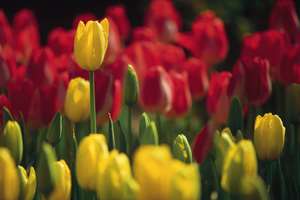
Tulips are a welcome part of the spring landscape, but to enjoy their benefits in warm weather, work must be done during fall. Fall is the optimal time to plant tulips and other spring-flowering bulbs to maximize their spring potential.
Iowa State University Extension and Outreach horticulturists can help answer questions about tulips and other spring-flowering bulbs, and how to handle them in fall weather. To have additional questions answered, contact the ISU Hortline at 515-294-3108 or hortline@iastate.edu.
What are good planting sites for tulips?
Tulips perform best in partial to full sun. Planting sites should receive at least six hours of direct sun per day. Tulip bulbs also need a well-drained, fertile soil.
When is the best time to plant tulips?
October is the ideal time to plant tulips, daffodils and other spring-flowering bulbs in Iowa. When planted in October, spring-flowering bulbs have time to develop a good root system before the ground freezes in winter. If the ground isn’t frozen, tulips and other spring-flowering bulbs can be planted as late as late November/early December.
How deep should tulips be planted?
Tulip bulbs should be planted 6 to 8 inches deep and 4 to 6 inches apart. Plant 10 or more bulbs of the same cultivar in an area to achieve the greatest visual impact in the garden.
Which are the best tulips for perennializing?
Most modern tulip cultivars bloom well for only three or four years. However, there are some tulip types (classes) that bloom well over a longer time period.
Darwin hybrid tulips are generally the longest blooming hybrid tulip. Darwin hybrid tulips are prized for their large, brilliant flowers. Flowers are available in shades of red, pink, orange, yellow and white. Blooms are borne on stems that are up to 30 inches tall. Darwin hybrid tulips bloom in mid-spring.
Fosteriana tulips also perennialize well. They are noted for their large, elongated flowers. Flowers appear in early spring on 10- to 20-inch-tall stems. Foliage is typically green or gray-green. However, a few cultivars have mottled or striped foliage. Fosteriana tulips are also known as Emperor tulips.
Species tulips are generally the longest lived tulips. Some naturalize when given favorable growing conditions. Species tulips include wild tulip species and cultivars developed from these wild species. Species tulips are usually smaller than most modern tulips. They also have smaller flowers. Species tulips are excellent choices for rock gardens and in the front of beds and borders. They also are sometimes referred to as botanical tulips.
Source:iastate.edu